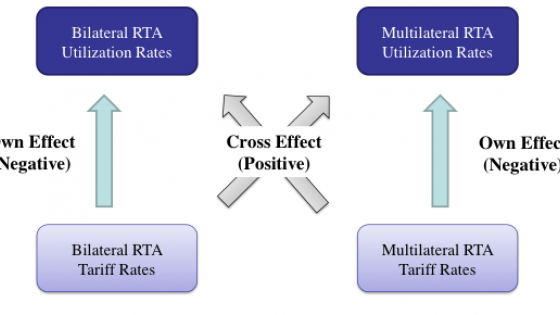A new VoxEU.org eBook, Catalyst? TTIP’s impact on the Rest, identifies the possible negative and positive impact of TTIP for third nations.
Grand ambitions
Ever since government leaders on both sides of the Atlantic launched the negotiations towards a Transatlantic Trade and Investment Partnership (TTIP) in June 2013, it has been claimed that this accord will provide a blueprint for global trade rules for decades to come (Barroso 2013). Exactly how this would come about has not been spelled out, but it could involve TTIP’s rules eventually being adopted in a new set of accords at a reinvigorated World Trade Organization (WTO). In principle, then, much more is at stake than freeing transatlantic commerce.
The motivations behind TTIP will shape the outcome. The EU negotiating mandate, which reflects in part objectives shared with the US, was released to the public by the Council of the European Union in June 2013.1 In market access, the objectives are to remove import duties on goods and restrictions on services, open up government procurement, and facilitate investment. The mandate also calls for improved regulatory coherence and cooperation through dismantling unnecessary regulatory barriers. On rules, the parties seek to improve cooperation in setting standards. Taken at face value, this constitutes an “ambitious, comprehensive, and balanced”2 enterprise aimed at raising income and creating jobs on both sides of the Atlantic. To date no provisions allowing third parties to join TTIP are envisaged, thereby limiting those parties’ options and shifting the focus to TTIP’s likely impact on outsiders.
Dominoes redux?
That regional trading arrangements (RTAs) can have adverse effects on third parties provides an incentive for the latter to join the former. In this manner RTAs can beget further RTAs, much like a sequence of falling dominoes (Baldwin 1993). To proponents of Competitive Liberalization, however, the fear of exclusion from a sizeable RTA softens up opposition by third parties to multilateral trade deals (Bergsten 1996). While the logic and evidence supporting these claims has been contested, some strategists may regard TTIP as an effective means by which two large trading blocs can optimise their clout as they experience relative economic decline. Much turns, then, on whether TTIP will harm third parties and how the latter can respond.
The likely economic consequences of TTIP for third parties
Analyses in this new Vox eBook identify both potentially negative and positive results for third parties from TTIP. Positive consequences could arise from deeper integration of the two largest economies in the world. If standards were harmonised, for example, exporters to the TTIP zone would only have to worry about compliance with a single regime in an enlarged market. In reality, this particular eventuality can be discounted because the emphasis in the negotiations is on mutual recognition and equivalence, not on harmonisation. A second potential benefit from TTIP is an income effect. To the extent that efficiency gains are made and trade costs reduced, a growth dividend could be forthcoming from which all parties can benefit.
Negative outcomes flow essentially from three main sources that could hit both trade and investment. First, there may be a direct discriminatory effect that asserts itself though trade diversion. TTIP will be super-imposed on a series of existing preferential agreements. Tariff reductions in TTIP will shuffle effective tariff preference margins, for example, with preference erosion a significant possibility in some sectors and for some economies. Similar effects can occur with regulatory changes, including of a procedural nature, giving rise to what has been referred to as ‘regulatory diversion’. Diversionary effects might be lessened for those countries that have negotiated agreements with a most-favoured-nation clause that automatically entitles them to new preferences within TTIP.
Second, import restrictions may increase as a result of new regulations or regulatory arrangements that ultimately reduce market access. These would not be presented as import restrictions, but they would act like them. Third, new regulations might raise production costs in third party economies and reduce competitiveness.
One suggestion made for reducing the trade-restrictive and cost-increasing consequences of regulatory reform would be to require that convergence occurs to the least rigorous pre-existing standard. If most of the action on the regulatory front is going to be in the nature of mutual recognition or equivalence agreements, the risk of upward harmonisation would not seem great. Still, many factors that impact on trade costs (such as the difficulties for developing countries in meeting stringent standards or regulations) would be in play in the regulatory field, with uncertain consequences for access.
Overall, though, the contributors to this eBook take different views on how likely increased discrimination and market access restrictions will be in a post-TTIP world, including:
- Rears of far-reaching negative consequences;
- The conjecture that only goods trade will be seriously affected because the prospects for progress in services look bleak;
- Predictions of minimal overall effects because of economic structures and the composition of trade and investment flows or because of the limited reach of the negotiated outcome; and
- A greater emphasis on positive opportunities that will flow from closer EU/US integration.
Scope for countervailing action by the Rest
The national contributions to this eBook from Australia, Brazil, China, India, Korea, Russia, South Africa, and Turkey are where most of the proposals for remedial initiatives are made. As noted above, views differ as to the magnitude of the likely effects of TTIP. Some fear the worst and others believe the consequences will not be great. There were broadly three kinds of damage-minimising courses of action proposed.
First, several authors argued that vulnerability was in part a function of poor domestic policies and that perhaps this debate offered an opportunity to undertake reforms at home. These would be a mixture of additional market opening, measures to reduce administrative trade costs, and other kinds of domestic regulatory reforms. By making their own economies more competitive, the argument goes, it would be easier to withstand pressure arising from changed conditions in the country’s major foreign markets.
Second, some authors were of the view that the TTIP protagonists were unconcerned about adverse third party effects. They suggested options for minimising such effects. These suggestions are diverse and include reducing secrecy in the negotiations, promoting dialogue, and designing integration approaches that would be least discriminatory towards outsiders and least corrosive of trading opportunities. The latter could include designing standards and regulation as inclusively as possible, flexible rules of origin, and preferential access to the TTIP market for outsiders.
A third proposal was to intensify cooperation with other countries as a means of counterbalancing the weight of TTIP. The main vehicle for such an approach would be to forge new or deeper preferential arrangements. Another suggestion is to work towards revitalising the WTO and to use it as an instrument for blunting preferentialism. This second option is attractive, but it has its challenges. Influential emerging economies and the major industrial countries, including the EU and the US, would need to be willing to work meaningfully to repair, reform, and update the WTO. Such a stance would weaken an alibi for preferentialism, which has it that a weakened WTO makes the institution’s relative neglect essentially in the national interest – a contention that overlooks the fact that we are talking about the same decision-makers in both contexts.
Must TTIP force the Rest into major trade deals?
The Rest will hardly stand by should TTIP be negotiated successfully. The question is how the Rest will respond? Ultimately, the Rest have options that go beyond negotiating trade accords. Third parties may, for example, unilaterally adopt key TTIP regulatory standards if they think that is in their interests. They don’t need to sign a RTA with either the US or EU to do this. Moreover, if the competitive disadvantage created by TTIP for a third party is so great, the latter may undertake reforms to their national business environment. For sure, such reforms may benefit American and European commercial interests, but it is far from clear that TTIP will trigger other major trade deals, including reviving the WTO. Fewer dominoes may fall than some expect.
References
Baldwin (1993). Richard E. Baldwin. “A Domino Theory of Regionalism,” NBER Working Paper number 4465.
Barroso (2013). Jose Manuel Barroso. Remarks by President Obama, U.K. Prime Minister Cameron, European Commission President Barroso, and European Council President Van Rompuy on the Transatlantic Trade and Investment Partnership. Office of the Press Secretary. The White House. 17 June.
Bergsten (1996). C. Fred Bergsten. “Competitive Liberalization and Global Free Trade: A Vision for the Early 21st Century.” Peterson Institute for International Economics Working Paper 96-13.
Footnotes
[1] The mandate can be downloaded at http://data.consilium.europa.eu/doc/document/ST-11103-2013-DCL-1/en/pdf.
[2] Ibid., paragraph 2.





